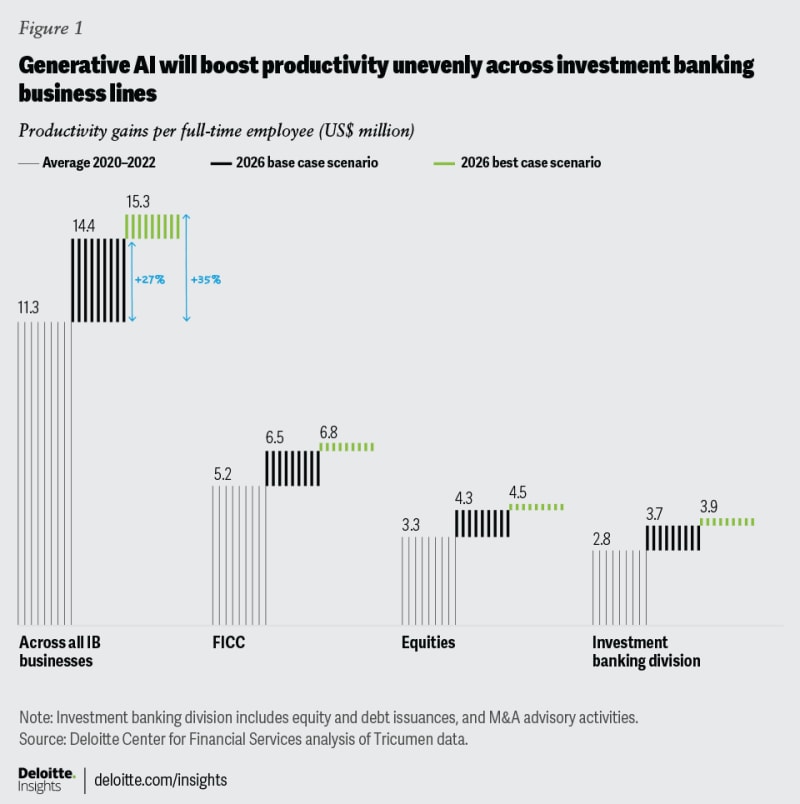Investment banks can benefit from generative AI in multiple ways
AI and automation are not new to investment banking. In fact, machine learning/deep learning algorithms and natural language processing (NLP) techniques have been widely used for years to help automate trading, modernize risk management, and conduct investment research. However, despite the billions of dollars spent on automating the various functions across the transaction life cycle, there are still a fair number of tasks that are conducted using precious human capital.
But large language models (LLMs) could help automate many tasks, not only saving money but also improving worker productivity. It could also free up resources to spark innovation and enable front-office staff to focus more on productively interacting with clients.
Generative AI can have a large impact on productivity across financial services
Results of recent studies on generative AI’s impact on productivity look promising. One study by Stanford researchers found that generative AI boosted a call center’s productivity by 14%.3 Another study by Massachusetts Institute of Technology concluded that generative AI helped reduce time and improve the quality of work for marketers, consultants, and data analysts.4 One common finding is that the technology can level the playing field and can, in particular, assist lower-skilled employees improve their outputs and productivity. Nonetheless, initially, lower-skilled workers may need to exert greater validation efforts.
Given such promise, the industry is swarming with numerous proofs-of-concept (POCs) and experiments. JPMorgan Chase recently applied to trademark a product called “IndexGPT” that offers investment advice to customers.5 Wells Fargo is using LLMs to help determine what information clients must report to regulators and how they can improve their business processes.6
When Federal Reserve researchers evaluated GPT models’ ability to “decipher Fedspeak” (i.e., classify Federal Open Market Committee announcements as dovish or hawkish), they found that the algorithms not only were superior to other methods but also demonstrated reasoning abilities on par with humans.7 Several institutions are already using similar GPT models to analyze official statements and speeches produced by central banks.
Vendors to investment banks have also increased their investments in the new technology. Bloomberg recently launched “Bloomberg GPT,” a large language model built on 50 billion parameters and tailored for finance.8 Similarly, Pitchbook has a new tool called “VC Exit Predictor” that uses a machine learning algorithm to predict a startup’s potential growth prospects.9
How generative AI can help investment banking front-office operations
Generative AI should be especially fruitful in areas where the output generation effort is high and validation is relatively easy.10 In the investment banking context, this capability can enable front-office employees to do their jobs better across a spectrum of activities, including marketing, sales, decision support, research, and trading, thereby boosting productivity. Professionals in these areas spend an enormous amount of time creating pitch books, industry reports, investment theses, performance summaries, due diligence reports, etc. Generative AI can help reduce the cost of content creation, enhance analytical capabilities, improve the electronification processes, and even reduce client call transfer rates.
Investment banks such as Goldman Sachs are also leveraging generative AI to help developers and coders create robust code more efficiently.11 Such competence is only expected to improve as these LLMs are trained on more parameters.
Our analysis suggests that the use of generative AI can boost productivity for front-office employees by as much as 27%–35% by 2026, after adjusting for inflation.12 This translates to an additional revenue of US$3 million to US$4 million per employee from an average of $11.3 million during 2020–22 (figure 1).







